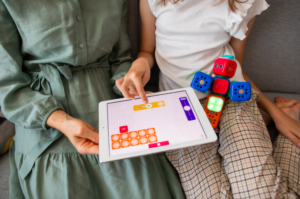If you are looking to teach your students about counting, look no further! These fun counting games are adapted from the book Games for Math by Peggy Kae.
1) Adapted Simon Says Game
In the original Simon says game, the leader/teacher of the group says, “Simon says, ‘touch your nose,’” and the group of students touches their noses. Then, the leader could say, “Touch your knees.” However, whoever touches their knees is taken out of the game because the leader did not say “Simon says…”. You can easily adapt this game to help your students learn to count and follow direction. For example, the leader/teacher could say,“Simon says, ‘touch your nose 6 times.’” Together, the group of students counts to 6 as they do the actions!

2) Number Collages
In the Number Collages game, students can cut or rip pictures out of newspapers and/or magazines. Next, the teacher asks them to count how many pictures they might include on their collages, improving students’ counting capabilities. Teachers can also make this like a scavenger hunt game. For example, teachers could ask students to cut out 5 pictures of animals and 9 pictures of people. Afterwards, students can make fun and personal collages with the pictures.
3) The How Many Game
Ask your students to count how many of a certain item are located in your classroom. How many posters? How many desks? Students better their counting skills through this engaging game. This game uses everyday situations to include counting exercises.
4) The Pennies Game
Teachers can give students pennies to count into groups of, let’s say, 10 pennies. You can change the amounts of pennies depending on what addition facts your students need to master. After students count the pennies, teachers ask them to make different shapes using the groups of 10 pennies. Students can glue the pennies onto pieces of construction paper or arrange patterns on their desks. This captivating game will help students realize that the same amount of pennies can make different sizes and shapes, contributing to their creative thinking skills. Teachers can also change up the game by asking students to count how much money they have if other coins are used as well.
5) Grasshopper Game
In this fun game, teachers lay out pieces of paper with numbers 1-10 on the ground. Next, teachers ask the students to jump to a certain number. For instance, the teacher could say, “jump to 6,” and later “jump to 6 minus 2.” Teachers can include some mathematical formulas to get the students to think about different math concepts. If there are many students, teachers can turn this game into a contest. Teachers will ask students to jump to a number, using math commands. The students turn continues until they get a command wrong. The student with the highest number of correct answer hops wins the game!

6) Estimating Game
In this game, teachers ask their students to estimate the amount of items left in various containers. Teachers can use containers filled with classroom materials such as markers, blocks, or, a student favorite, jellybeans. Estimating amounts of certain items is an important skill for children as they can determine if their answers/ideas are within a reasonable range.
7) Number Stories
Teachers can tell an interesting story, in which each student can add or subtract objects from the story. So, if the teachers says, “I found myself in the forest with 17 birds. Then, rain started and 4 flew away. How many birds are left now?” students are asked to add or subtract. Alternatively, students can add to the story by saying, “There are 13 birds now, but 6 more birds flew away.” Students love the interactive part of number stories!
8) Biggest and Smallest
The Biggest and Smallest game uses 2 or 3 dice. Teachers roll the dice before coming up with different numbers using the numbers rolled. For example, the teacher rolls a 1 and a 2, then the students come up with 21 or 12. Students can then ask the students which is a bigger number. Students can continue adding up the numbers with previous rolls, so which ever students reaches 1000 first wins the game!
Written by Chelsea Kowal
Visit the NSTEM page for more posts about our STEM community!

